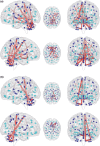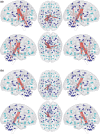Structural and functional hyperconnectivity within the sensorimotor system in xenomelia
- PMID: 28293484
- PMCID: PMC5346531
- DOI: 10.1002/brb3.657
Structural and functional hyperconnectivity within the sensorimotor system in xenomelia
Abstract
Introduction: Xenomelia is a rare condition characterized by the persistent and compulsive desire for the amputation of one or more physically healthy limbs. We highlight the neurological underpinnings of xenomelia by assessing structural and functional connectivity by means of whole-brain connectome and network analyses of regions previously implicated in empirical research in this condition.
Methods: We compared structural and functional connectivity between 13 xenomelic men with matched controls using diffusion tensor imaging combined with fiber tractography and resting state functional magnetic resonance imaging. Altered connectivity in xenomelia within the sensorimotor system has been predicted.
Results: We found subnetworks showing structural and functional hyperconnectivity in xenomelia compared with controls. These subnetworks were lateralized to the right hemisphere and mainly comprised by nodes belonging to the sensorimotor system. In the connectome analyses, the paracentral lobule, supplementary motor area, postcentral gyrus, basal ganglia, and the cerebellum were hyperconnected to each other, whereas in the xenomelia-specific network analyses, hyperconnected nodes have been found in the superior parietal lobule, primary and secondary somatosensory cortex, premotor cortex, basal ganglia, thalamus, and insula.
Conclusions: Our study provides empirical evidence of structural and functional hyperconnectivity within the sensorimotor system including those regions that are core for the reconstruction of a coherent body image. Aberrant connectivity is a common response to focal neurological damage. As exemplified here, it may affect different brain regions differentially. Due to the small sample size, our findings must be interpreted cautiously and future studies are needed to elucidate potential associations between hyperconnectivity and limb disownership reported in xenomelia.
Keywords: body integrity identity disorder; diffusion tensor imaging; limb amputation; resting state functional magnetic resonance imaging; sensorymotor system; structural and functional hyperconnectivity.
Figures




References
-
- Aoyama, A. , Krummenacher, P. , Palla, A. , Hilti, L. M. , & Brugger, P. (2011). Impaired spatial‐temporal integration of touch in xenomelia (body integrity identity disorder). Spatial Cognition & Computation, 12, 96–110.
-
- Behrens, T. E. J. , Woolrich, M. W. , Jenkinson, M. , Johansen‐Berg, H. , Nunes, R. G. , Clare, S. , … Smith, S. M. (2003). Characterization and propagation of uncertainty in diffusion‐weighted MR imaging. Magnetic Resonance in Medicine, 50, 1077–1088. - PubMed
-
- Berlucchi, G. , & Aglioti, S. M. (2010). The body in the brain revisited. Experimental Brain Research, 200, 25–35. - PubMed
-
- Blanke, O. , Morgenthaler, F. D. , Brugger, P. , & Overney, L. S. (2009). Preliminary evidence for a fronto‐parietal dysfunction in able‐bodied participants with a desire for limb amputation. Journal of Neuropsychology, 3, 181–200. - PubMed
Publication types
MeSH terms
LinkOut - more resources
Full Text Sources
Other Literature Sources
Medical
Research Materials

